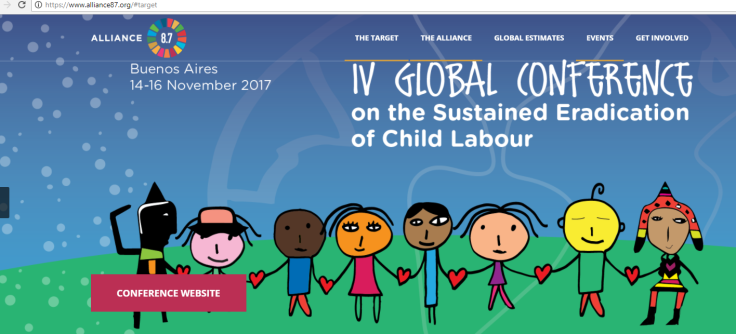
Around the world there are 151,6 million children of the age 5 to 17 doing child labour. UNICEF states that around 1 in 4 children are occupied in child labour in the world’s poorest countries.
Where does ‘child labour’ start? According to UNICEF it starts when the children are too young to work or when the work is harmful to the children. They call it hazardous work when the activity is dangerous and unsafe for the children and have a harmful effect on the children’s physical, mental, educational or social development.
The Alliance published that 72,5 million of the kids doing child labour do work that is hazardous and a big risc for their health, safety or moral development.


In child labour some children are working weeks of more than 43 hours. Nearly a third of children in child labour cannot take part in the education system. The children who are able to go to school often perform more poorly than their peers who are not working. The time and energy they spend working degrade their abilities. They do not profit fully from classroom lessons and from study outside the classroom.

The map shows the percentages of child labour in different countries. As it is visible on the picture the most countries in Africa experience child labour. (1999-2006)
In Africa one in five children is involved in child labour. Africa is the region in the world where the risk of child labour is greatest. It is followed by Asia and the Pacific. A higher number of boys than of girls is involved in child labour. Girls often have more jobs in the household.


In many countries children work mainly in agriculture. Seven in ten children in child labour do work in agriculture. This work includes farming, fishing, forestry, aquaculture and livestock. Most of these child workers (67,5%) are family members and don’t get even payed.
An investigation by 16×9 in Ghana showed that many cocoa beans in that country are harvested by children. Many of the kids don’t have a choice. Some are even slaves. All workers, young or old, live in poverty.

In the industry sector: Mineworking is another field of child labour. Children have to go deep underground in tunnels that are only as wide as their bodies are. They have to pull or drag coal that weights more than they do. Children have to use their hands to work gold out of rocks and use toxic.
Also in cobalt mining child labourers work. Major electronics brands, including Apple, Samsung and Sony, are failing to do basic checks. They cannot ensure that cobalt mined by child labourers has not been used in their products (report Amnesty International and Afrewatch). Leading electric car makers General Motors (GM), Renault-Nissan and Tesla have failed to make the steps public they are taking to ensure that cobalt mined by child labourers is not used in their batteries. Children as young as seven are cobalt mining in the Democratic Republic of the Congo (DRC).
In the textile industry or the leather tanneries child labourers are also exposed to dangerous chemicals again and again. In the fashion supply chain there is a lot of child labour. A lot of the work is low-skilled labour. Some of the tasks suit even better to children than adults. For example in cotton picking, employers prefer to hire children for their small fingers, which do not damage the crop.
One of the worst and most horrible actions of adults is to use children for fighting or working in wars. This happens in at least 17 countries in different regions around the world. Some children are used as fighters others have to do supportive work (like cooks, messengers, porters, spies) or for sexual purpose. According to ILO Convention No.182 (forced) recruitment of children for use in an armed conflict is defined as a worst form of child labour.
Another crime of adults is the commercial sexual exploitation of children under 18 years old for payment. Examples are child prostitution, child sex tourism, production, promotion and distribution of pornography where children are involved, use of children in sex shows (public or private).
Child labour is a violation of the human rights of children and adolescents.
Children are seen as dutiful workers without a voice who are easy to command. There is no supervision and no social control mechanisms, no union taking care. No-one who is asking for better working conditions or more salery, children are very low-skilled workers who cannot defend themsleves. So they are easy targets. Parents or family members living in great poverty often sell their own children into slavery. The younger the child the more money traders in children (traffickers) can make.
The fashion supply chain is hugely complex. It is hard for companies to control every stage of production. So employers get away with it as that makes it possible to employ children without big brands and consumers ever finding out.
About 20% of the child labourers suffer from severe illness or injuries during work. This often leads to permanent disabilities.
From 2000 on the number of children in child labour went down with 94 million. It is a development in the right direction but the number must decrease further to zero.
literature:
http://www.ilo.org/ipec/facts/lang–en/index.htm
https://www.alliance87.org/2017ge/childlabour#!section=0
https://child-freedom-org.weebly.com/what-is-child-labour.html
https://data.unicef.org/topic/child-protection/child-labour/#
https://www.compassion.com/poverty/child-labor-quick-facts.htm
http://www.ilo.org/ipec/areas/Armedconflict/lang–en/index.htm
http://www.ilo.org/ipec/areas/CSEC/lang–en/index.htm
http://www.ilo.org/ipec/areas/Miningandquarrying/lang–en/index.htm
https://labs.theguardian.com/unicef-child-labour/
https://www.amnesty.org/en/latest/news/2016/09/electric-cars-running-on-child-labour/
Recente reacties